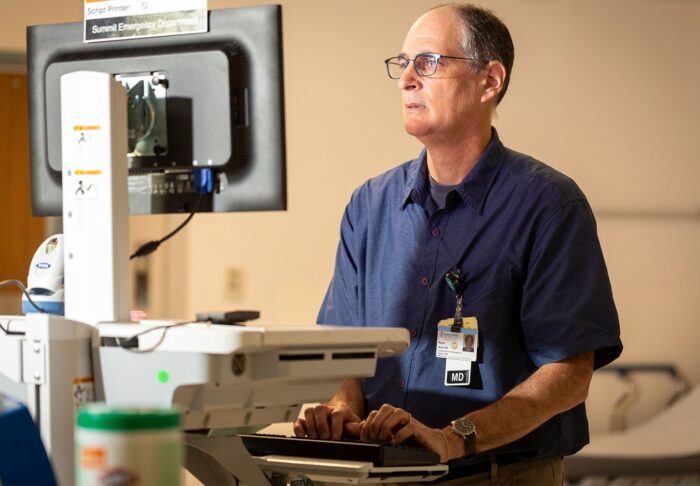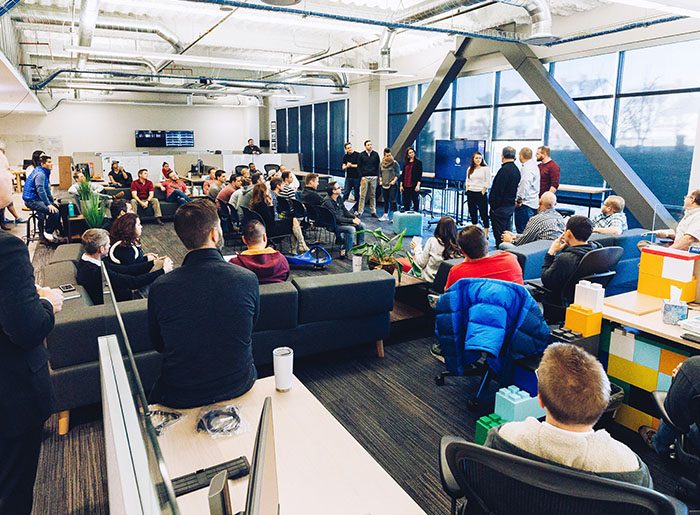|
Getting your Trinity Audio player ready…
|
Imagine you’re an emergency room doctor staring down at a nonresponsive patient. You open the electronic health record to learn about her history, and all you find is a record from an ICU stay in your hospital four years ago. You assume she has probably had treatment since then, but you have no idea what type. You try calling the phone numbers listed for the patient’s primary care provider and the patient’s son, but it is 2 AM, and neither is answering. You need information now.
What you don’t know is that just 12 days ago, this patient was admitted to a hospital only blocks away. That hospital ran the full gamut of relevant tests, prescribed several medications, scheduled follow-up appointments with various specialists, and developed a comprehensive care plan. So you unknowingly order the exact same work all over again. Time is lost. Money is wasted. The patient’s quality of care suffers.
Situations like this arise often in emergency rooms and clinics around California, inhibiting providers from delivering high-value care. They are failures of coordination and basic information exchange. It’s indisputable that providers cannot effectively coordinate a patient’s care without access to a shared set of accurate information about that patient. That’s what Utah-based Collective Medical aims to provide, and that’s why it has received the CHCF Innovation Fund’s latest program-related investment.

To be sure, this is not the only patient information sharing tool. For example, California is home to more than 15 community-based health information exchanges (HIEs). Those HIEs have made great progress in establishing the culture of trust and collaboration required for community stakeholders to share data. Many of these exchanges have become repositories of comprehensive patient information from a diverse array of local organizations, including payers, providers, home health agencies, and nursing homes. Their new challenge is making those data easily digestible, immediately accessible, and actionable for providers when and where they are delivering care.
Tools like the Collective system can add value to what HIEs have already built. In fact, the company has partnerships with more than a dozen HIEs across the country. In California, Inland Empire Health Plan recently facilitated a partnership between Collective and Manifest MedEx, a statewide HIE. They plan to test whether Collective’s analytical power and Manifest MedEx’s deep data sets can combine to help providers at 10 Inland Empire network hospitals deliver better care.
Collective’s unique algorithms distill large clinical data sets, like those an HIE might have, into a concise summary of the crucial information needed by a provider to make a given treatment decision. The Collective platform delivers that information directly within a provider’s existing workflow, unlike many other data-sharing tools that may require separate logins or extra clicks. According to a recent American Hospital Association survey (PDF), both small and large hospitals cited “information not being available to view in the electronic health record as part of clinicians’ workflow” as the biggest barrier to using information shared by outside providers.
In our opening scenario, if both hospitals had belonged to the Collective Medical network, the recent hospitalization and summarized outcomes would have been flagged within the patient’s health record, thereby preventing unnecessary treatment at the second hospital. Collective’s platform also would have alerted in real time the patient’s established care team and her health plan about the admission and enabled them to collaborate on a care plan to prevent future hospitalizations. Closing those gaps in care coordination can have a big impact on outcomes and costs.

Collective shared with me the story of a homeless patient who struggled with complex mental health issues but had finally secured an appointment to obtain a housing voucher at the local housing authority. On the day of that appointment, she began to feel disoriented and overwhelmed and ended up at an emergency department (ED) instead of the housing authority. Through Collective’s platform, the ED alerted her community-based mental health care team to the situation. A member of that team was quickly able to arrive at the ED, prevent the patient from being admitted, and reschedule the housing authority appointment for later that day. The care worker then drove the patient to the appointment, and she secured her housing voucher. She is no longer homeless.
So how does Collective get its data? As soon as a hospital, HIE, or clinic joins the Collective network, their eligible electronic health data become available for Collective’s tools to search and share with other network members as needs arise. This creates a “network effect,” and as the Collective network grows, so too does its value to members.
That’s what leaders at Washington state’s hospitals realized. In 2012, as part of the state’s “ER is for Emergencies” initiative, every hospital in the state joined the Collective network. The impact was impressive.
Reducing Preventable Emergency Visits
According to a Brookings Institution analysis (PDF) of the state’s first year on the network, reduced emergency room visits saved Washington’s state Medicaid program nearly $34 million. Within the Medicaid population, ED visits by high utilizers of care, many of whom had both mental health and substance use issues, declined by approximately 11%. ED visits resulting in the prescription of controlled substances fell by 25%. Finally, more than 420 primary care providers received alerts when their patients were admitted to the ED, helping to close a common care coordination gap.
Although Collective got its start in EDs, it has adapted its technology to other settings both inside and outside a clinic’s walls. Collective can summarize for a busy primary care doctor a patient’s recent specialist visits. It can alert a health plan when a patient with complex needs is having trouble and should receive additional care resources. The benefits of these varied uses of Collective’s technology are likely to be magnified in the safety net, where time and money are always scarce. We aim to test that assumption through our investment. Collective will use our funding to expand its California network to include more plans, hospitals, and community clinics serving Medi-Cal patients, and to form more partnerships with California HIEs like the one they recently began with Manifest MedEx.
We have also made grant funding available to safety-net entities that want to use Collective but need assistance with one-time implementation costs. We have done so to ensure that cost barriers do not inadvertently create information deserts, such as rural or low-income areas where clinics may have limited IT budgets.
Finally, we are funding an evaluation that will track — within a single safety-net health system using Collective systems — a defined Medi-Cal population with complex needs. The evaluators will assess the impact of Collective’s tools on the cost, quality, and use of emergency and primary care services by those patients.
As Collective’s expansion into California’s safety net takes shape and evaluation data emerge, we will share new insights with you.
Authors & Contributors




